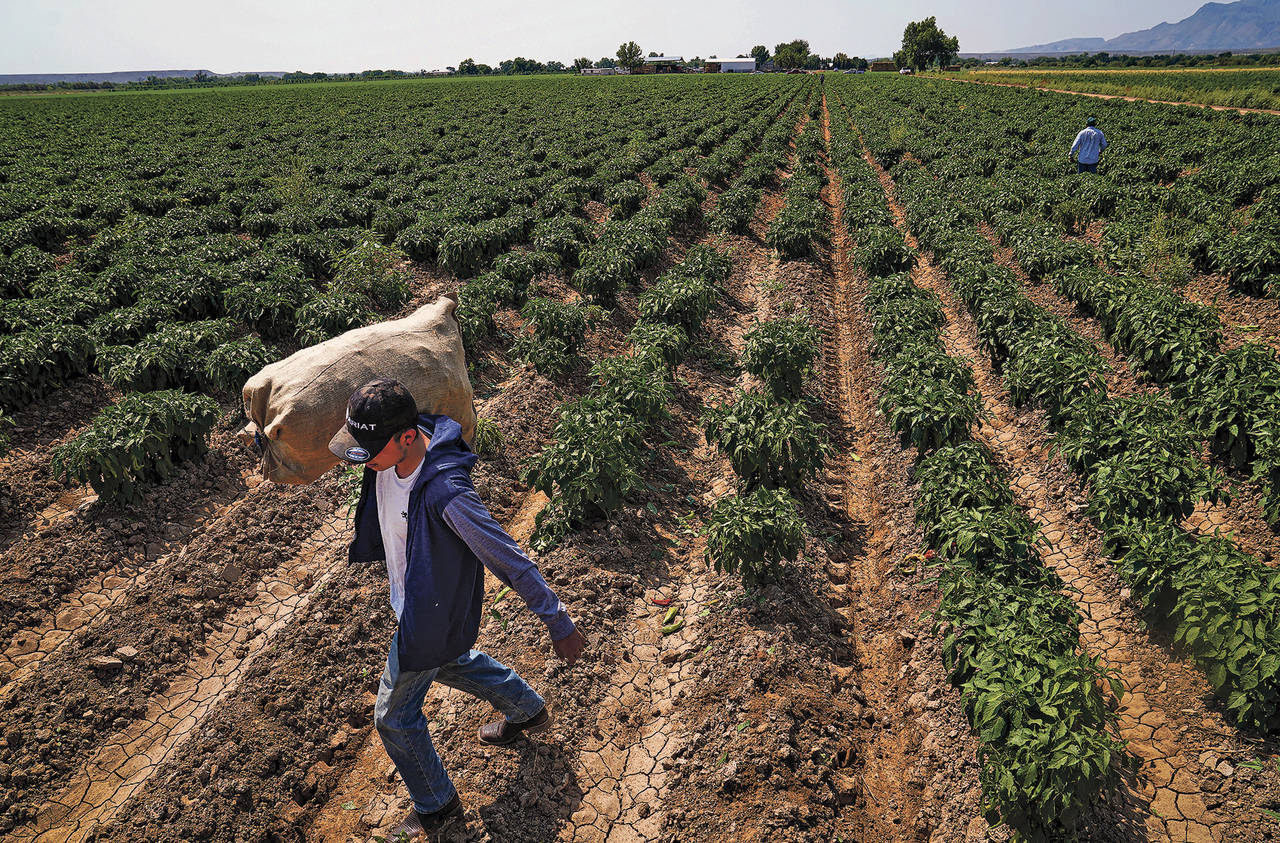Dwindling Colorado River Basin key to New Mexico agriculture
Sep 17, 2022, 7:10 PM | Updated: Sep 18, 2022, 7:11 am

Workers harvest and bag green chile on Glen Duggins' farm in Lemitar, N.M., on Aug 27, 2020. Duggins, who grows chile, alfalfa and vegetables, found himself praying for rain in June and feeling grateful to receive some water from the Colorado River Basin. (Gabriela Campos/Santa Fe New Mexican via AP)
(Gabriela Campos/Santa Fe New Mexican via AP)
SANTA FE, N.M. (AP) — Glen Duggins, who grows chile, alfalfa and vegetables, found himself praying for rain in June and feeling grateful to receive some water from the Colorado River Basin.
A La Nina weather pattern had caused an exceptionally dry winter and spring, depleting the Rio Grande, the main water source for farmers to irrigate about 60,000 acres in this area of New Mexico.
The water that carried them through the last arid weeks before the rains came was diverted from the Colorado River Basin through a federal system of tunnels and dams known as the San Juan-Chama Project. This water merges with the Rio Grande to augment regional supply.
“It got us through the hump and got us into monsoon season,” said Duggins, who owns a 400-acre farm in Lemitar, a hamlet in the Middle Rio Grande Valley.
___
EDITOR’S NOTE: This is part of a collaborative series on the Colorado River as the 100th anniversary of the historic Colorado River Compact approaches. The Associated Press, The Colorado Sun, The Albuquerque Journal, The Salt Lake Tribune, The Arizona Daily Star, The Nevada Independent and The Santa Fe New Mexican are working together to explore the pressures on the river in 2022.
___
San Juan-Chama accounts for the bulk of the water New Mexico gets from the Colorado River Basin. There are some historic users such as Navajo Nation farmers diverting water separately from the federal system.
Although the basin provides only about 10% of New Mexico’s total water supplies, how this water is used is essential, causing concerns about how climate change and increased demand are diminishing the Colorado River and prompting calls for the seven states within the basin to further reduce consumption.
New Mexico taps 4 million acre feet of water yearly, half from various rivers and half from the ground — with about 400,000-acre feet of surface water coming from the basin, said Rolf Schmidt-Peterson, Interstate Stream Commission director.
An acre foot is about 326,000 gallons, enough to supply two or three households in a year.
The U.S. Bureau of Reclamation allocates San Juan-Chama water every year to Albuquerque, Santa Fe, middle valley irrigators and three Native users — Jicarilla Apache Nation, Taos Pueblo and Ohkay Owingeh.
New Mexico is one of four states in the upper basin and is allotted 11.25 percent of the available water per year within this group under a 1948 agreement.
New Mexico is required to send a certain amount of water downstream mostly in the San Juan River, which flows to the Navajo Reservoir and eventually into Lake Powell. The Reclamation Bureau diverts the leftover water upstream to cover New Mexico’s allotment.
The state’s share is unchanging despite increasing demand.
A pipeline is now being installed called the Navajo Gallup Water Supply Project. Slated to be completed in three years, it will divert about 37,000 acre feet from the San Juan to provide drinking water to parts of the Navajo and Jicarilla nations as well as Gallup.
At the same, the Pojoaque regional water system is being built that will supply 4,000 acre feet of San Juan-Chama water to four Native pueblos by the end of the decade.
As of August, New Mexico users have received little more than half of their maximum allocation. Reductions are evenly shared, so one user doesn’t receive a higher percentage than another.
In the past decade, as the drought has dragged on, the bureau has only made a full allocation in the relatively wet years of 2013, 2017 and 2019. The trend is likely to continue as the climate grows warmer and drier, reducing snowpacks, increasing evaporation and parching soils that absorb runoff.
“Aridification will likely reduce inflow to the San Juan-Chama Project,” said Carolyn Donnelly, the bureau’s water operations supervisor. “This year we saw much higher rain inflow to the project, but it did not make up for lower than average snowpack.”
The head of the regional irrigation district said although this water is a small part of what middle valley farmers use, it’s crucial in dry periods during the growing season such as earlier this summer.
“We used every bit of that San Juan-Chama water before the rains happened,” said Jason Casuga, CEO and chief engineer for the Middle Rio Grande Conservancy District.
Receiving increasingly less of the water is a troublesome trend, Casuga said. Being shorted on the water can cause problems later in the season if the rains dissipate because there’s no reserve to draw from, Casuga said.
Schmidt-Petersen said as haggling over Colorado River water continues, especially between states in the upper and lower basins, the priority is to be civil in finding strategies for ensuring future water supply for everyone.
“We recognize that there are differences within the basin, and as the strain on the supply increases, tensions rise and cooperation becomes even more challenging,” Schmidt-Petersen said. “We are committed to protecting New Mexico’s water supply while fulfilling compliance with interstate compacts and the law of the river generally.”
Both Santa Fe and Albuquerque built treatment plants more than a decade ago to divert San Juan-Chama water from the Rio Grande and ease the strain on their wells — and now the cities have both river and groundwater to draw from, said Reed Benson, water law professor at University of New Mexico.
Both cities have made efforts to conserve water, with per-capita use decreasing as their populations have grown, Benson said. Albuquerque has established programs such as paying residents to remove their grass lawns, he said.
Schmidt-Petersen sees a similar trend among irrigators: the overall water use has gone down even as the number of farmers has risen.
The upper basin states have submitted a five-point water-saving plan to the bureau to help meet officials’ demand for reduced consumption. It’s not clear how much more water the upper basin states, including New Mexico, can give up, he said.
“A lot more? Probably not,” he said. “But we’ll try to do our part.”
Copyright © The Associated Press. All rights reserved. This material may not be published, broadcast, rewritten or redistributed.














